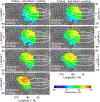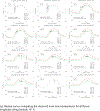Maps of Tethys' Thermophysical Properties
- PMID: 33005060
- PMCID: PMC7526067
- DOI: 10.1016/j.icarus.2018.12.018
Maps of Tethys' Thermophysical Properties
Abstract
On 11th April 2015 Cassini's Composite Infrared Spectrometer (CIRS) made a series of observations of Tethys' daytime anti-Saturn hemisphere over a nine-hour time period. During this time the sub-spacecraft position was remarkably stable (0.3° S to 3.9° S; 153.2° W to 221.8° W), and so these observations provide unprecedented coverage of diurnal temperature variations on Tethys' anti-Saturn hemisphere. In 2012 a thermal anomaly was discovered at low latitudes on Tethys' leading hemisphere; it appears cooler during the day and warmer at night than its surroundings (Howett et al., 2012) and is spatially correlated with a decrease in the IR3/UV3 visible color ratio (Schenk et al., 2011). The cause of this anomaly is believed to be surface alteration by high-energy electrons, which preferentially bombard low-latitudes of Tethys' leading hemisphere (Schenk et al., 2011; Howett et al., 2012; Paranicas et al. 2014; Schaible et al., 2017). The thermal anomaly was quickly dubbed "Pac-Man" due to its resemblance to the 1980s video game icon. We use these daytime 2015 CIRS data, along with two sets of nighttime CIRS observations of Tethys (from 27 June 2007 and 17 August 2015) to make maps of bolometric Bond albedo and thermal inertia variations across the anti-Saturn hemisphere of Tethys (including the edge of its Pac-Man region). These maps confirm the presence of the Pac-Man thermal anomaly and show that while Tethys' bolometric Bond albedo varies negligibly outside and inside the anomaly (0.69±0.02 inside, compared to 0.71±0.04 outside) the thermal inertia varies dramatically (29±10 J m-2 K-1 s-1/2 inside, compared to 9±4 J m-2 K-1 s-1/2 outside). These thermal inertias are in keeping with previously published values: 25±3 J m-2 K-1 s-1/2 inside, and 5±1 J m-2 K-1 s-1/2 outside the anomaly (Howett et al., 2012). A detailed analysis shows that on smaller spatial-scales the bolometric Bond albedo does vary: increasing to a peak value at 180° W. For longitudes between ~100° W and ~160° W the thermal inertia increases from northern to southern latitudes, while the reverse is true for bolometric Bond albedo. The thermal inertia on Tethys generally increases towards the center of its leading hemisphere but also displays other notable small-scale variations. These thermal inertia and bolometric Bond albedo variations are perhaps due to differences in competing surface modification by E ring grains and high-energy electrons which both bombard Tethys' leading hemisphere (but in different ways). A comparison between the observed temperatures and our best thermal model fits shows notable discrepancies in the morning warming curve, which may provide evidence of regional variations in surface roughness effects, perhaps again due to variations in surface alteration mechanisms.
Figures












References
-
- Abramov O, A Rathbun J, Schmidt BE and Spencer JR, Detectability of thermal signatures associated with active formation of ‘chaos terrain’ on Europa, Earth and Planetary Science Letters 384, 37–41, 2013.
-
- Buratti B and Veverka J, Voyager Photometry of Rhea, Dione, Tethys, Enceladus and Mimas, Icarus 58, 254–264, 1984.
-
- Elder C, Helfenstein P, Thomas P, Veverka J, Burns JA, Denk T and Porco C. Tethys’ Mysterious Equatorial Band, Bulletin of the American Astronomical Society 39, 429, 2007.
-
- Filacchione G, D’Aversa E, Capaccioni F, Clark RN, Cruikshank DP, Ciarniello M, Cerroni P, Bellucci G, Brown RH, Buratti BJ, Nicholson PD, Jaumann R, McCord TB, Sotin C, Stephan K, Dalle Ore CM, Saturn’s icy satellites investigated by Cassini-VIMS. IV. Daytime temperature maps, Icarus 271, 292–313, 2016.
-
- Flasar FM, Kunde VG, Abbas MM, Achterberg RK, Ade P, Barucci A, Bézard B, Bjoraker GL, Brasunas JC, Calcutt SB, Carlson R, Césarsky CJ, Conrath BJ, Coradini A, Courtin R, Coustenis A, Edberg S, Edgington S, Ferrari C, Fouchet T, Gautier D, Gierasch PJ, Grossman K, Irwin P, Jennings DE, Lellouch E, Mamoutkine AA, Marten A, Meyer JP, Nixon CA, Orton GS, Owen TC, Pearl JC, Prangé R, Raulin F, Read PL, Romani PN, Samuelson RE, Segura ME, Showalter MR, Simon-Miller AA, Smith MD, Spencer JR, Spilker LJ and Taylor FW. Exploring the Saturn System in the Thermal Infrared: The Composite Infrared Spectrometer, Space Science Review 115, 169–297, doi: 10.1007/s11214-004-1454-9, 2004. - DOI
Grants and funding
LinkOut - more resources
Full Text Sources
Miscellaneous
